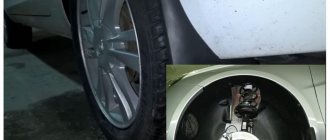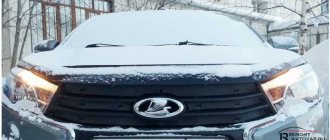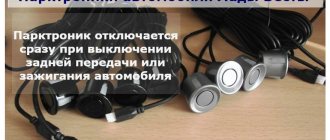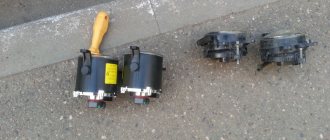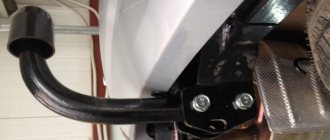Almost all modern cars, especially those belonging to the B-class, suffer from insufficient noise insulation in the area of the wheel arches. Lada Vesta SW is also no exception. In an attempt to save money and offer the buyer a better price, manufacturers reduce the cost of the design as much as possible. To get rid of this problem, you can simply install the fender liners of the Lada Vesta SV.
If you remember the first Lada models, you understand that almost all of them had plastic fender liners as a mandatory attribute. At that time, this was not just some useless tuning, but a really necessary modification to the car. Why? Read the article further.
Which fender liners should I choose for the Lada Vesta SV?
The main criteria for choosing lockers are as follows:
- factor No. 1: dirt should not settle on the surface, and the structure itself can be easily washed and cleaned;
- factor No. 2: partial protection of the body from corrosion, oxidation of the metal surface (factory treatment of wheel arches with anti-gravel is not enough, because during the operation of the car sand, dirt, and crushed stone fly out from under the wheels, damaging the paintwork);
- factor No. 3: additional sound insulation of the interior, which is so lacking in domestic cars.
Fly swatter
With this element, owners try to protect the car from chips and other damage. But a fly swatter does not protect against them; chips still appear. The attachment points of the fly swatter are usually subject to corrosion. It does not matter how the installation takes place (armored film, rubber bands, spacers).
In any case, when moving, everything moves, sand and reagents penetrate everywhere. This is wasted money and damage to the hood. The paint may also fade unevenly.
Main types of fender liner
- Universal front and rear fender liners for Lada Vesta: manufactured by third-party manufacturers. The material used is plastic, most often of low quality. During prolonged use in the cold, the polymer bursts, cracks form, and deformation occurs. Relatively low cost is the main feature of “station wagons”.
- Branded standard fender liners (article 8454543565) are made with the addition of polyethylene. The material withstands high and low temperatures well and is not subject to deformation or corrosion. The service life of such lockers is many times longer than universal ones. At the same time, the price is 15% more expensive than analogues.
- Felt fender liners (liquid): A new type of wheel arch protection is a mixture of rubber and resin. Applied to the metal surface on the inside of the wing. A certain protective layer is formed. The service life is 5 – 6 years, after which it is necessary to update the “mastic”. High cost is one of the main disadvantages.
- Protection with noise insulation and vibration insulation layer.
Reference on topic:
Canister ventilation valve on Lada Vesta: purpose, prevention, replacement
Manufacturers and prices
When purchasing or placing an order, you need to clarify the body of your Vesta to avoid confusion.
| Manufacturer | vendor code | Body | Set | Price, rub.) |
| LADA | 99999218001086 | Sedan/SW | 4 units | 5 222 |
| LADA | 99999218101086 | Sedan Cross/SW Cross | 4 units | 5 300 |
| Autofamily | TOTEM.52.33.001 | SW/SW Cross | Front left | 1 050 |
| Autofamily | NLS.52.33.001 | Sedan | Front lion | 1 250 |
| ActiveAvto | 108-59 | Sedan | Rear left | 950 |
| Rival | 46002002 | Sedan/Sedan Cross/SW/SW Cross | Rear right | 790 |
Installation of fender liners on Lada Vesta
Preparation of the workplace, necessary tools
- a flat-head, Phillips-head screwdriver;
- TORX wrench with socket set;
- rags;
- liquid for removing rust deposits WD – 40;
- hammer;
- plastic caps;
- a new mudguard if the old one is damaged.
Step-by-step instructions for installing the front fender liner
- We hang the front of the car with a hydraulic jack.
- Unscrew the bolts and remove the wheel.
- We rinse the arch cavity from the inside with water. Dry thoroughly.
- We unscrew the four bolts and the plug that holds the standard mudguard to the body.
- We apply the locker to the body, mark points - places where holes for self-tapping screws are likely to be drilled. We treat them with Litol lubricant to prevent the formation of corrosion.
- We screw in the screws and fix the mudguard.
- We put on the protection, the wheel on the splines, and tighten the bolts.
Installation of the locker yourself is completed. Installation of the rear fender liner is carried out according to similar regulations.
We evaluate the build quality of Lada Vesta: a victim of logistics
New models are never perfect. Lada Vesta is no exception. Vadim Kryuchkov and Alexey Revin spent a lot of time in the garage, fussing with VAZ’s new product and studying the flaws in its assembly.
LADA > Vesta
Too many cooks spoil the broth.
And Lada Vesta today is that same child. The degree of localization of production is about 70%, and other parts and assemblies are either assembled here from imported components and materials, or purchased abroad. The car was developed domestically, but, as they say, not without help. Engines and gearboxes are made in Tolyatti, assembly is organized in Izhevsk. But our distances are long, and sometimes booming logistics leads to a decline in quality.
Would you like to see this with specific examples? The ZR editorial office now has two Vestas: a red one with a robotic gearbox and a brown one with a manual transmission. A meticulous inspection and the first thousand kilometers showed that the ideal has not yet been achieved.
Body
Sedans look better with side windows that visually continue the glazing of the rear doors. And they go to Vesta. But the gluing of these triangles leaves much to be desired - they sit unevenly and asymmetrically.
The red Vesta has a gap between the trunk lid and the rear fender on the left - 3 mm, and on the right - 5.5 mm, almost twice as much. When resold, such a Lada will most likely be mistaken for a poorly restored one after an accident.
In both cars, the fog lamp holders do not fit well into the bumper openings: on the red one there are gaping gaps, on the other the seal sticks out sloppily. Mud flaps and fender liners do not fit tightly to the surface of the front fenders on both cars. On brown, the mudguards protrude more, on red - the fender liners.
On the brown Vesta, the rear fender liners are made of two parts of molded non-woven material and sewn together with ordinary rusting steel clips. Moreover, their number in the fender liners of the right and left arches is different.
The inside handle of the front passenger door on a brown car is installed with a gap of more than 3 mm. The rest fit tightly.
A cooled glove box appeared on the Lada for the first time. But the execution is lame. The air supply nozzle is half blocked by the foam seal that has come out.
All listed defects are assembly defects. It doesn’t matter where the conveyor is located - in Togliatti or Izhevsk, the plant simply must eliminate such defects quickly.
Are there any design flaws? There will be some.
Due to the insufficient rigidity of the brackets, the gas tank hatches do not fit tightly in the openings. Simply put, the fastenings are flimsy. The play in the vertical plane is such that strong shaking can cause the hatches to come into contact with the side of the body and, as a result, damage to the paintwork.
The hood locking levers bend when opening, and on one of the cars the lever also hangs loosely on the axle. Hence the constant jamming. The situation is aggravated by the ill-conceived design of the front of the hood and the upper part of the radiator grille, which direct the flow of dirt towards the lock and the locking lever axis.
The quality of components is also poor. The cars have covered less than 10 thousand kilometers each, but the windows of the front doors are already badly scratched. This may indicate both insufficient hardness of the glass and an unsuccessful design of their external seals. In this case, there are more questions about the glass supplied by the Turkish Sisecam Group. Why did you change supplier? There are far fewer comments about the products of the Bor Glass Factory, which are installed on Tolyatti cars of other models. In front of the editorial office are the seasoned Granta, Kalina and Datsun mi-DO - not a scratch on the side windows.
Conclusion
The procedure for installing fender liners on a Lada Vesta car yourself is not at all complicated. The task can be accomplished even by an inexperienced car enthusiast. If any difficulties arise during installation, please contact a service station for help.
Car service workers strongly recommend purchasing branded lockers and then installing them, since it is the “originals” that guarantee full compatibility with the body structure of your vehicle.
As an alternative, consider purchasing plastic fender liners.
Body edge protection
Many car enthusiasts try to protect body edges from impacts and damage, such as doors. In this case, a special film is glued or other elements are put on. In the first case, the film does not spoil the view and provides protection.
Experts have different opinions on external seals. There will be protection for a while, but then salt, dirt, reagents, and moisture will become clogged. The result is corrosion. This is not entirely the right decision. It is better to hold the door while opening.
Reviews
| № | Positive |
| 1 | Andrey (Avtodrom): after buying the car I installed plastic lockers, I’ve been driving for three years without any complaints. |
| 2 | Sergey (Avtotema): I’m happy with the lockers, they’re a little noisy on gravel, but this is compensated by the low price. |
| 3 | Kirill (Autoreview): installed original lockers on Lada Vesta. The price was steep, but the quality was good. |
| 4 | Alexey (Avtoria): the fender liners have been installed for the second year, they fit tightly and are sealed. |
| 5 | Alexander (Drom): installed the lockers on his own, completed it in a total of an hour and a half. |
| 6 | Stanislav (Driving): the protection is good, practical, and does not deform in the cold. |
| 7 | Vasily Alekseevich (“5th wheel”): Three years have passed since the installation of the lockers, there are no complaints. |
| Negative | |
| 8 | Vitaly (Avtotema): the plastic locker burst in winter, replaced it with a new one. |
| 9 | Svyatoslav (Otzovik.net): the price of original lockers is unreasonably high. |
| 10 | Vlad (ProAvto): there are no particular complaints about the plastic, but it creaks in severe frost. |
Related link:
How to remove the dashboard on a Lada Vesta.
Winter radiator protection
The plugs are made of plastic or soft material (fabric, tarpaulin). There is no need to do this. This may be justified if you live in the far north, where there are very severe frosts. If this is the middle zone, then closing the radiator for the winter is simply nonsense. You have a modern car with a normal cooling system. If it's working, then you don't need these things.
It is known that the car gets hot with them, and can cause the engine to overheat. If you work in a taxi or as a sales manager, buy a special blanket. It will prevent the engine from cooling quickly and will save some fuel.
Purpose of lockers
Fender liners (lockers) are a very useful protective element. After all, it prevents the most dangerous and detrimental factor for metal interacting with water - metal corrosion. Undoubtedly, there are metal materials that, due to their chemical composition, are capable of resisting corrosion, but they are expensive and are not used in the production of Lada cars. Therefore, to extend the service life of the car and protect the metal from which the bottom is made, it is necessary to equip Vesta with lockers.
Not only VAZ cars, but seventy percent of the world's cars are equipped with this protective element.
Like Vesta's predecessors, the new sedan is not equipped with factory fender liners at the manufacturer. There are rubber mud flaps built into the wheel arches, which are not an effective means of protection. In order to reduce the noise level from the wheels and reduce the effect of corrosion on the underbody parts, drivers have to independently equip Vesta with lockers.
FakeHeader
Comments 22
Good job. They just protect the place where sandblasting occurs from the rear wheels.
Did you glue the felt ones back in place?
Yes, I took it off, coated it and put it back, they are now plastic on top!
Have you checked how the felt ones feel under the plastic ones? Post a photo of the rear ones, how yours is tucked behind the bumper. Thank you
Yes, you’re finally fearless, I see, damn it - on this plastic misunderstanding, without safety nets, you can lift the car and hold it suspended.
Apparently he lifted it with two.
Yes, you’re finally fearless, I see, damn it - on this plastic misunderstanding, without safety nets, you can lift the car and hold it suspended.
